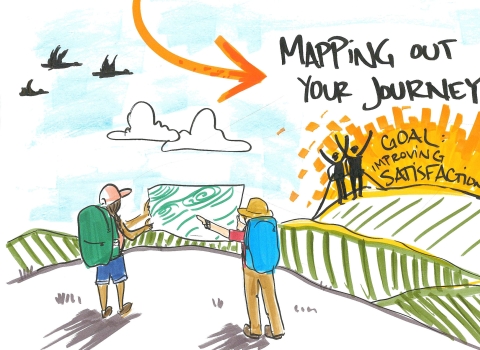Jason Showalter stands across a canyon draw at the base of Mother Miguel Mountain, gazing at its newly constructed zigzag trail. Native wildflowers dance in the foothill breeze.
“This trail has had a profound effect on my life,” said Showalter, a former board member of the San Diego Mountain Biking Association. “It’s because of the people. The passion you all have is real. It’s addicting.”
He will never forget his ‘first date’ as he calls it, on January 2, 2009, with the U.S. Fish and Wildlife Service’s San Diego National Wildlife Refuge Manager Jill Terp.
“We bickered like an old married couple,” he chuckled. “But like I said when I resigned from the board of the association, the greatest thing out of all of this was meeting Jill Terp.”
Steeped in knowledge of the refuge’s draft Comprehensive Conservation Plan and the San Diego Multiple Species Conservation Plan, Showalter came to Terp with his concerns about trails on the refuge.
“He had really done his homework to learn about why the refuge was established,” she said.
Showalter looks at nature differently since their meetings about popular trails on the refuge. As they hiked many miles together and got to know what each other’s goals were, their level of trust grew as an important friendship blossomed.
“Before, I used to see ground,” he said. “Now I see habitat. Rocks equal homes for wildlife.”
Over the years, Showalter became a conduit of communication between an overwhelmed refuge manager trying to balance conservation with recreation and a rapidly growing group of passionate trail users.
A challenge for design
Mother Miguel Trail had become informally known to the locals as the “Rockhouse Trail” due to the large pile of rocks atop the 1,527-foot peak. Thanks to popularity fueled by social media and trail apps, it had become badly eroded in recent years.
Hikers, mountain bikers, and equestrians walking straight uphill in the slippery dirt and rocks created a wide eyesore of a “scar” that now clawed up the mountain at an unsafe 30 percent slope. Even if they mapped out new switchbacks, it still wouldn’t be a desirable slope for preventing future erosion.
To add to that, Showalter and Terp encountered several sensitive species such as the endangered Quino checkerspot butterfly and its host plant, Plantago erecta. “After four hours, we’d only gone about 40 yards,” said Showalter. “We tried using the clinometer to pick a route, but then [Terp would] see a whole sea of plantago or a patch of cryptobiotic crust,” he threw up his hands. “There were many days like that, but we kept pushing on.”
Pushing on so much that Terp broke her ankle one day while working on the reroute with another refuge staff member, and had to be airlifted to an awaiting ambulance.
Frustrated by the setback, Terp nursed her ankle while other refuge staff and partners from the San Diego Mountain Biking Association, Bonita Bikers, Bonita Valley Horsemen and Earth Discovery Institute stepped in to continue their mutual goal.
Harnessing outdoor enthusiasm
One local volunteer, Mark Kukuchek, brought a unique contribution being a Bonita Biker and a committee chairperson of the Bonita Valley Horseman. He believed in giving back to the trails he enjoyed, and regularly patrolled via horseback on other local trails.
“When we were working on the trail here, I pushed to keep it open,” he said. “We need to let people in, but without letting the trail get loved to death.”
Terp agreed. To build support within the community and harness the incredible amount of interest, Terp decided to keep the trail open during the extensive reroute work.
“We have this great opportunity to connect our neighbors with nature,” said Terp. “We’re hoping that by us being out here to help them understand the ‘why,’ it will increase respect for wildlife overall and compliance for staying on the trail.”
She organized outreach days with her trusted partners at the institute, as Showalter and others led volunteers in the backbreaking trail work, which could only occur after rains because of the rock hard ground. What’s more, the nesting season for the federally threatened California gnatcatcher constrained their work during the spring and summer.
Using hand tools like pick axes and McLeods, pounding in fence posts, and moving rocks to fortify new switchbacks, the volunteers led by certified trail bosses slowly but surely started to see their hard work come to fruition.
“That scar motivated me,” said Showalter. “I wanted that thing gone.”
Public use pressure versus a legacy for conservation
Showalter’s curiosity in the refuge’s management may have started back in 2009, but in 2015 it reached a new level of advocacy. The San Diego National Wildlife Refuge was undergoing a major stage of their draft Comprehensive Conservation Plan: a final public meeting with over 300 in attendance.
“It was a media frenzy, and people yelled at the refuge staff,” said Showalter. “It hurt me to see my friends get disrespected. I knew all that they were up against.”
There were more challenges than just heavy trail use. The terrain, the endangered species and cultural resources, the public’s safety and the fact that the refuge did not own the land where the public enters to reach the trailhead made access and orientation difficult.
There was additional public pressure because of the recent closure of an illegal trail on neighboring Mount San Miguel, which had formed over the years after the devastating Harris Fire.
“We saw Mother Miguel as a compromise to still give people that peak experience,” said Terp.
Unfortunately, the “Rockhouse Trail” was exploding in popularity and the minimal refuge staff who worked there could not get to redesigning it fast enough.
It sounded like a great opportunity for another local mountain biker.
Rallying the community and building trust
Jose Galaz, who considers the wildlife refuge his backyard in suburban Chula Vista, is an Instagram-famous cyclist grandfather of two. Despite being a self-proclaimed introvert, he really has a knack for organizing groups.
“I started out just getting obsessed with riding and wanting to get in shape outdoors,” said Galaz. “It turned into me joining SDMBA (San Diego Mountain Biking Association) and Bonita Bikers, then getting this passion for changing bikers’ attitudes from just riding to actually caring about trails.”
Galaz channeled his passion into rallying his community of mountain bikers to work on Mother Miguel Mountain and invited them to learn something new about trails and wildlife.
“I want everyone to have a sense of ownership, but also connect with nature in addition to a workout,” he said. “And if we can build a trail on this crazy terrain – on a federal national wildlife refuge national wildlife refuge
A national wildlife refuge is typically a contiguous area of land and water managed by the U.S. Fish and Wildlife Service for the conservation and, where appropriate, restoration of fish, wildlife and plant resources and their habitats for the benefit of present and future generations of Americans.
Learn more about national wildlife refuge – we can do the same in other places.”
Galaz also saw Showalter as the person who opened the lines of communication between land managers and mountain bikers.
“I wanted to build that trust too,” he said. “And we did. It’s not a perfect trail, but it’s way better than I anticipated. I am very thankful for Jill especially, for giving us a chance to do this.”
She in return, is thankful for the 1,500 hours given by the mountain bikers and others who’ve contributed to it over the past three years.
Mother Miguel Mountain’s healing effect
As staff and volunteers continue their work in the future to heal the scars on Mother Miguel Mountain, another type of healing is taking place - in the relationships between trail users and land managers, and ultimately between humans and nature.
Because of the willingness of people like Showalter, Kukuchek, Galaz and many volunteers taking time to get to know land managers like Jill Terp, they established a trusting relationship. Through their community networks, these leaders conveyed their understanding about the refuge to others, resulting in newfound respect and a deeper appreciation for nature.
“How the Service responded to all this showed me how much they were willing to listen,” said Showalter. “From now on when I want to build a mountain biking trail, I ask permission, because now I understand the ‘why’ behind what they do. We all have to do our part to protect these places,” said Showalter.
In addition to the volunteers’ and partner contributions, the new Mother Miguel Mountain Trail is also supported by a generous grant from the San Diego Association of Governments.













